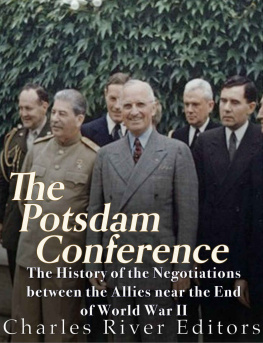Charles River Editors provides superior editing and original writing services across the digital publishing industry, with the expertise to create digital content for publishers across a vast range of subject matter. In addition to providing original digital content for third party publishers, we also republish civilizations greatest literary works, bringing them to new generations of readers via ebooks.
Sign up here to receive updates about free books as we publish them , and visit Our Kindle Author Page to browse todays free promotions and our most recently published Kindle titles.
Introduction

A picture of former Nazi rocket scientists at Fort Bliss, Texas
Operation Papercliip
After the last shots of World War II were fired and the process of rebuilding Germany and Europe began, the Western Allies and the Soviet Union each tried to obtain the services of the Third Reich's leading scientists, especially those involved in rocketry, missile technology, and aerospace research. Naturally, this was a delicate affair due to the fact many of the German scientists were not only active Nazis but had helped the Nazi war machine terrorize the world. At the same time, by the late war period, the Anglo-American Allies formed a clear picture of the Soviet state. Though forced to ally with the USSR's dictator, Josef Stalin, the West came to understand Communist Russia represented yet another hungry totalitarian power, and thus a very real threat to an independent Europe. British Prime Minister Winston Churchill realized the menacing character of the Soviets from the Katyn Forest Massacre of Polish army officers, if not before, while the Americans only gradually shed a nave assumption of continued Russian friendliness after the war.
For their part, the Soviets retained ruthless imperial ambitions which manifested in various ways. They allied with Hitler for a time in 1939 to 1941, planning to divide Eastern Europe between their two expansionist states. They devastated the Ukrainian population with the Holomodor, an engineered, genocidal famine which claimed perhaps 3 million victims. The Soviet refusal to evacuate Eastern Europe following the war, instead retaining many formerly democratic countries as vassal states, spoke volumes about their intentions.
Both the Western Allies and the Soviets knew of Adolf Hitler's V-2 rocket program, the forerunner of ballistic missiles and the space race. Each recognized the immense strategic value of these technologies and wished to secure their benefits for themselves. As the Soviets contemplated additional expansion following the Great Patriotic War and the U.S. military came to understand the putative allies of today would emerge as the enemies of tomorrow, the men possessing knowledge of the V-2 rockets and other Third Reich military technology programs became seen as crucial pieces in the incipient NATO versus Warsaw Pact standoff.
The result was the American-led Operation Paperclip on the Western side, which resulted in German scientists putting their expertise at the disposal of the U.S. and other NATO members. Operation Paperclip aimed not only to obtain the benefits of German scientific advances for the United States but also to deny them to the potentially hostile Soviets, as General Leslie Groves enunciated: Heisenberg was one of the world's leading physicists, and, at the time of the German break-up, he was worth more to us than ten divisions of Germans. Had he fallen into the Russian hands, he would have proven invaluable to them (Naimark, 1995, 207).
The Western approach, however self-interested, typically met with voluntary compliance on the German scientists' parts. In contrast, the Soviet answer to Paperclip, Operation Osoaviakhim, used the implied threat of imprisonment, torture, and death, the characteristic tools of Stalinist Russia, to coerce assistance from German scientists and engineers following the war. These men yielded rich dividends to the Soviet state in terms of achieving at least temporary technical parity with the USSR's western rivals.
To say Operation Paperclip had a profound impact on the Cold War and American history would be an understatement. The most well known example of the operations success is Wernher von Braun, who was once a member of a branch of the SS involved in the Holocaust, would become known as the father of rocket science and fascinate the world with visions of winged rockets and space stations as a new Manhattan Project, one that NASA would eventually adopt. And in addition to the weaponization of ballistic missiles that progressed throughout the Cold War, von Brauns expertise was used for Americas most historic space missions. NASA also had to develop rockets capable of first launching a spacecraft into Earths orbit, and then launching it toward the Moon. The Soviets struggled throughout the 1960s to design rockets up to the task, but thanks to von Braun, NASA got it right with the Saturn V rocket, which to this day remains the most powerful launching rocket NASA ever used.
Nazi Germanys Rocket Science: The History of the Third Reichs Experimental Weapons Technology and Research during World War II analyzes the Nazis technological advances and the covert attempts to import Nazi scientists after the fall of the Third Reich. Along with pictures of important people, places, and events, you will learn about Germanys rocket science like never before, in no time at all.
Chapter 1: Developing German Rockets
Though extremely different men in most ways, British Prime Minister Winston Churchill and Third Reich Fuhrer Adolf Hitler shared a passion for science, technology, and (sometimes impractical) wonder weapons. In some cases, this fixation paid off handsomely, as in the case of British centrimetric radar, a compact, powerful radar type that enabled fitment to individual aircraft and contributed to the defeat of German U-boats.
Germany's science obviously failed to snatch victory from the jaws of defeat as Hitler fondly imagined it might. Nevertheless, the Germans made several crucial advances, including the first functional jet fighter aircraft, infrared sights for sniper rifles, plans for a flying wing style aircraft, nuclear bomb research, and V-1 and V-2 rocket technology.
Though some of Hitler's weapon programs inflicted damage on the Allies, most proved counterproductive from the Third Reich's point of view. They used up vast quantities of money, material, and know-how which otherwise could have produced large numbers of ordinary but effective aircraft or vehicles. In effect, Germany's experimental science programs hindered its war effort and produced advances whose benefits accrued mostly to its enemies, both eastern and western. The V-2 rocket even caused problems for the German food supply, since each rocket's fuel required the rendering of 30 tons of potatoes to produce sufficient alcohol.
Most spectacularly, the Germans laid the groundwork for the era of ballistic missiles to follow with the Vengeance Weapons program. The advent of relatively advanced liquid and solid fuels for rocket weapons made them viable again after a period during which rifled artillery overshadowed them. An additional factor creating German interest in military rockets came from their complete omission among the restrictions placed on Germany's army by the Treaty of Versailles at the end of World War I. This major loophole led the Germans to hope improved rocketry could replace artillery, which the Treaty nearly banned.


















